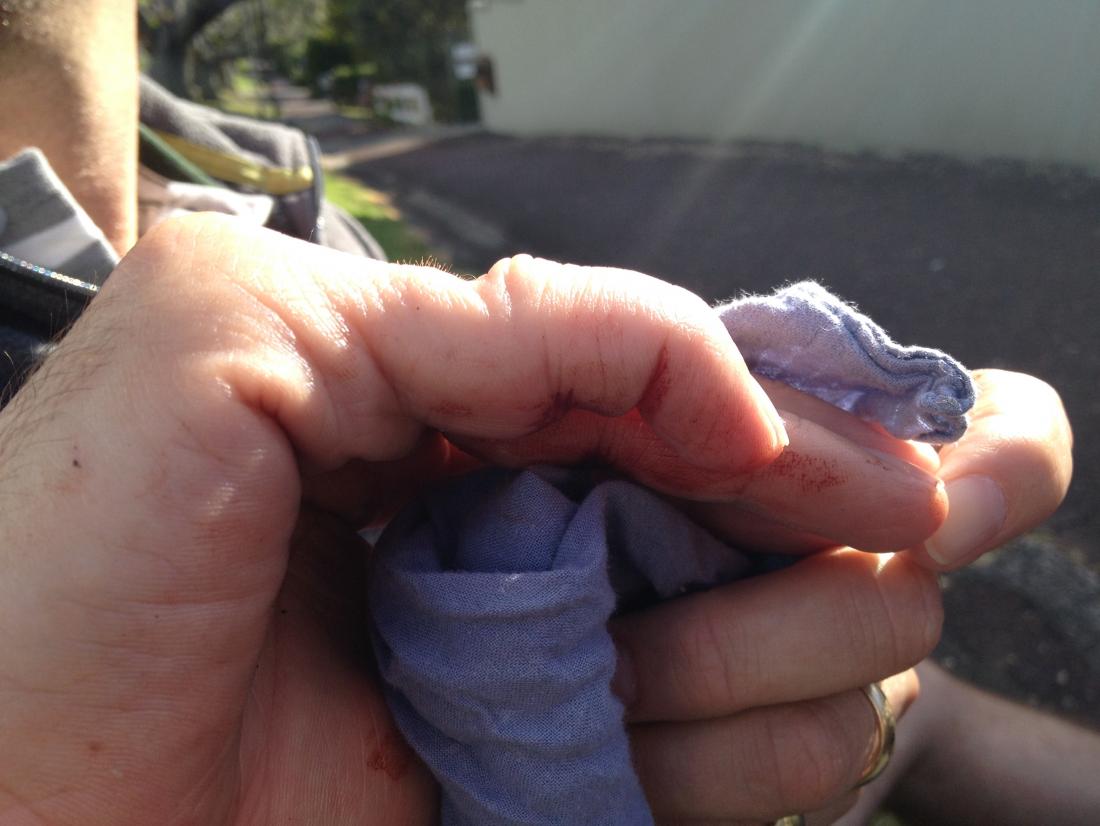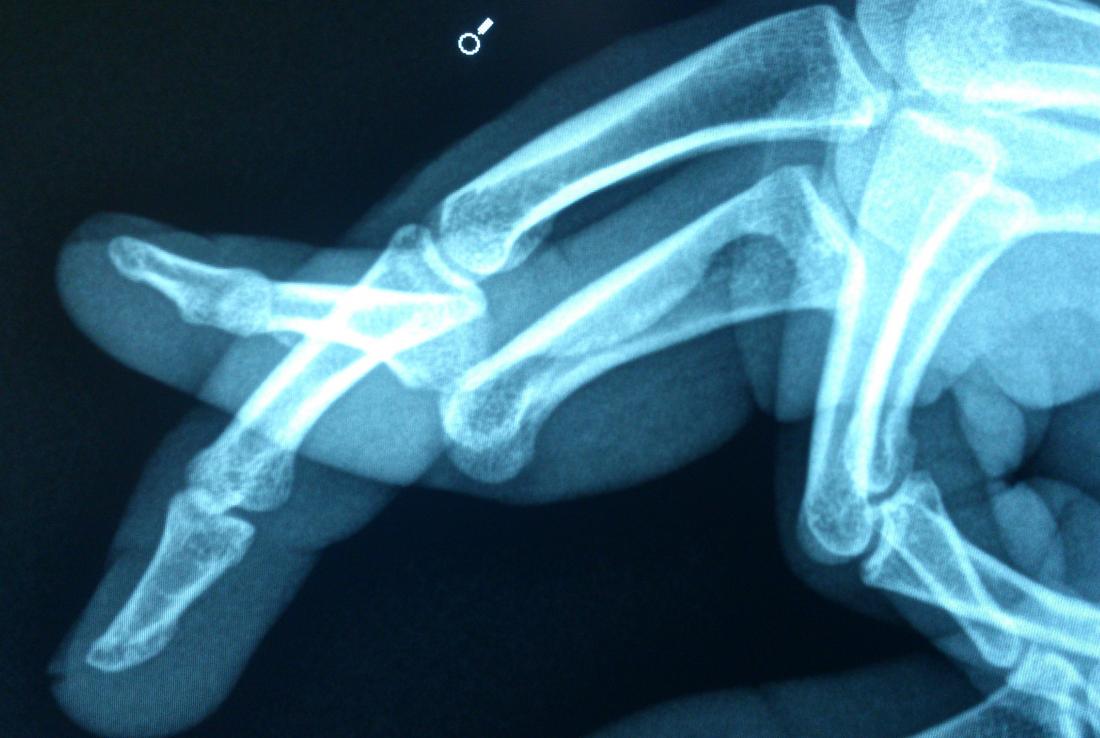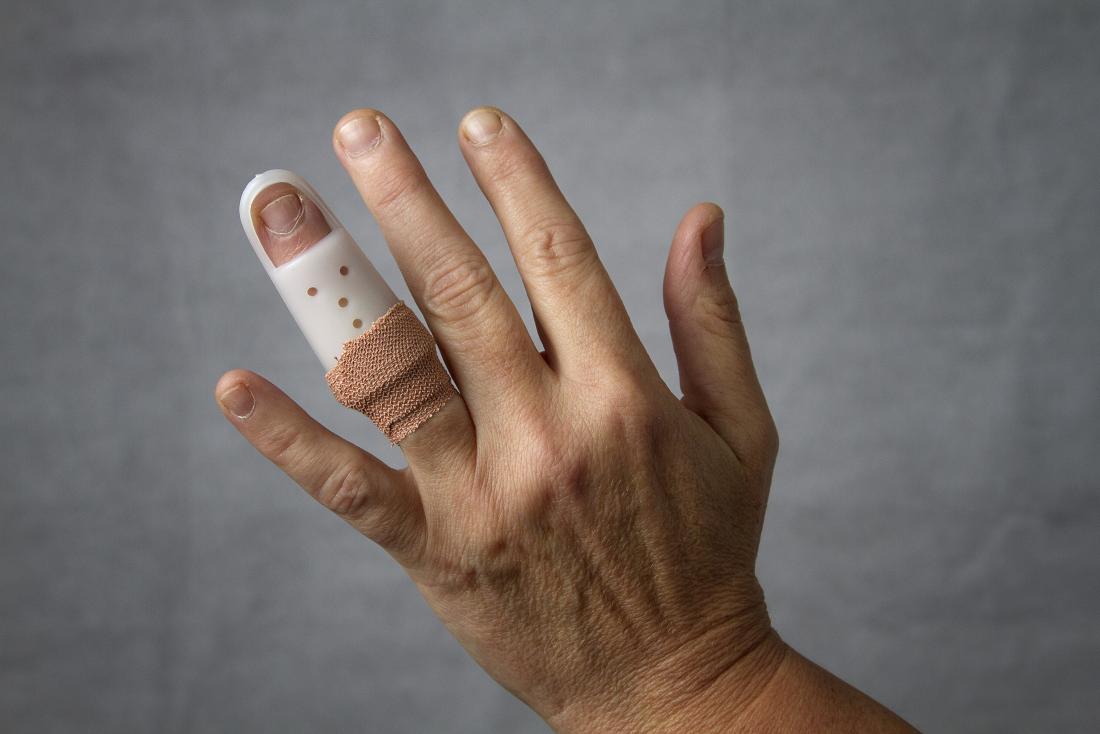Dislocating a finger or thumb can be extremely painful and distressing. Although dislocation is not a life-threatening emergency, it is still important to seek prompt medical attention.
This article describes what to do when a person dislocates their finger or thumb. It also discusses the symptoms, causes, treatment, and recovery for a dislocated finger.
What to do

A person should not try to relocate a dislocated finger themselves.
Image credit: Mdumont01, 2013
People who suspect they have dislocated their finger should seek immediate medical attention. While waiting for help or heading to a clinic, it is important not to move the damaged finger or thumb. Applying ice to the finger may help to reduce pain and swelling.
Do not attempt to move the finger bone back into its joint; a qualified healthcare professional must do this. Trying to relocate the finger bone without proper training can make the injury worse and cause additional pain and swelling.
People who attempt to move their own finger bone back into place also risk permanently damaging the surrounding structures, such as:
- tendons
- ligaments
- nerves
- blood vessels
- joint articular cartilage
Symptoms
A dislocated finger may appear swollen or crooked and is typically very painful.
Other signs that indicate a dislocated finger include:
- numbness or tingling
- bruising or discoloration of the skin
- difficulty moving the injured finger
Causes
Fingers contain three joints, and thumbs contain two. A joint is where the ends of two bones meet. Ligaments are short bands of fibrous material that hold the bones together and help support the joint.
Dislocations can occur when a significant force causes the ligaments to give way, causing the bone to slip out of the joint.
Sports injuries are a common cause of dislocated fingers. According to a 2015 review, around half of all sports-related hand affect the fingers. Sports with the highest rates of hand injuries include football, gymnastics, basketball, lacrosse, and wrestling.
Other possible causes of a dislocated finger can include:
- overextending the finger
- blunt force impact to the tip of the finger, or jamming
- falling on an outstretched arm
People with health conditions that can weaken joints and ligaments may be at greater risk of dislocations.
Diagnosis

A doctor may use an X-ray to confirm a dislocation or fracture.
A healthcare professional will examine the affected finger and ask the person about how and when the injury occurred. They may then order an imaging test to confirm a dislocation or evaluate the extent of damage to the finger.
Imaging tests for dislocated fingers include:
- X-ray. X-rays use electromagnetic radiation to create images of the body’s internal structures. Doctors use X-ray images to confirm dislocations and to check for fractures or breaks.
- MRI scan. An MRI scan uses strong magnetic fields and radio waves to create detailed images of the tissues inside the body. A doctor may recommend an MRI scan if they suspect significant tissue damage near the dislocated joint.
Treatment
Treatment options vary depending on the location and severity of the dislocation.
Reduction
The first step in treating a dislocated finger or thumb typically involves carefully manipulating the bone back into the joint. The procedure is known as reduction.
Before performing a reduction, the healthcare professional may use a local anesthetic to numb the affected area of the person’s hand.
After the healthcare professional has completed the reduction procedure, they may order an X-ray test to check the alignment of the bone inside the joint.
Immobilization
After reduction, a person will normally need to wear a splint to protect and immobilize the injured finger while it heals. A splint contains a rigid strip of metal that supports a broken or dislocated bone. Immobilization stops a person moving their finger and prevents them dislocating or injuring it again.
A healthcare professional may also recommend “buddy taping” the splinted finger to an adjacent finger. Buddy taping provides support for the injured finger while allowing a greater range of motion.
A person with a dislocated finger may need to wear the splint for several weeks. However, wearing a splint for too long may cause permanent stiffness and reduced mobility of the finger.
K-wire fixation
Depending on the type or severity of the injury, some people with a dislocated finger may also have a bone fracture. A fracture occurs when a significant amount of force impacts a bone causing it to splinter or break into two or more separate pieces.
Finger fractures also require reducing and splinting. Some people with finger fractures may require K-wire fixation. K-wires are thin metal rods that surgeons implant to help stabilize bone fragments.
Surgery
Dislocated fingers that involve torn ligaments, fractures, or broken bones may require a surgical procedure known as open reduction.
Like other treatments for dislocated finger, surgical procedures aim to reduce, stabilize and restore mobility to the finger without damaging surrounding structures.
Recovery

A person should ensure that they keep the finger splint clean and dry.
According to a 2017 review, dislocated fingers typically heal within 4 to 6 weeks. Factors that affect recovery time can include:
- the severity and location of the dislocation
- damage to ligaments and tendons
- bone fractures
- requiring surgery
Following reduction and splinting, some people may also require physical or occupational therapy. A physical or occupational therapist will show a person how to do exercises that strengthen the finger and improve the range of motion.
Some things people can do at home while their finger heals include:
- keeping their splint clean and dry
- keeping their finger elevated above the level of their heart to reduce swelling
- resting their finger and avoiding moving it during the healing process
- applying cold compresses or ice packs to reduce pain and inflammation
- taking over-the-counter medications, such as ibuprofen or acetaminophen, to help reduce pain and swelling
- regularly performing any finger exercises that a therapist recommends
Following recovery, a dislocated finger may be more prone to injury in the future. A person can reduce the risk of dislocating the finger again by:
- performing hand and finger exercises to strengthen muscles, tendons, and ligaments
- wearing a splint or buddy tape during sports activities
- avoiding wearing rings while playing sports
Summary
While painful and distressing, a dislocated finger is not a life-threatening emergency. However, it is important to seek prompt medical attention.
A person should not attempt to relocate the dislocated finger themselves. Manipulating the injured finger can cause additional damage to the joint or the surrounding structures.
Following medical treatment, dislocated fingers usually take a few weeks to heal. Bone fractures and damage to the surrounding tissues can significantly increase recovery time.
